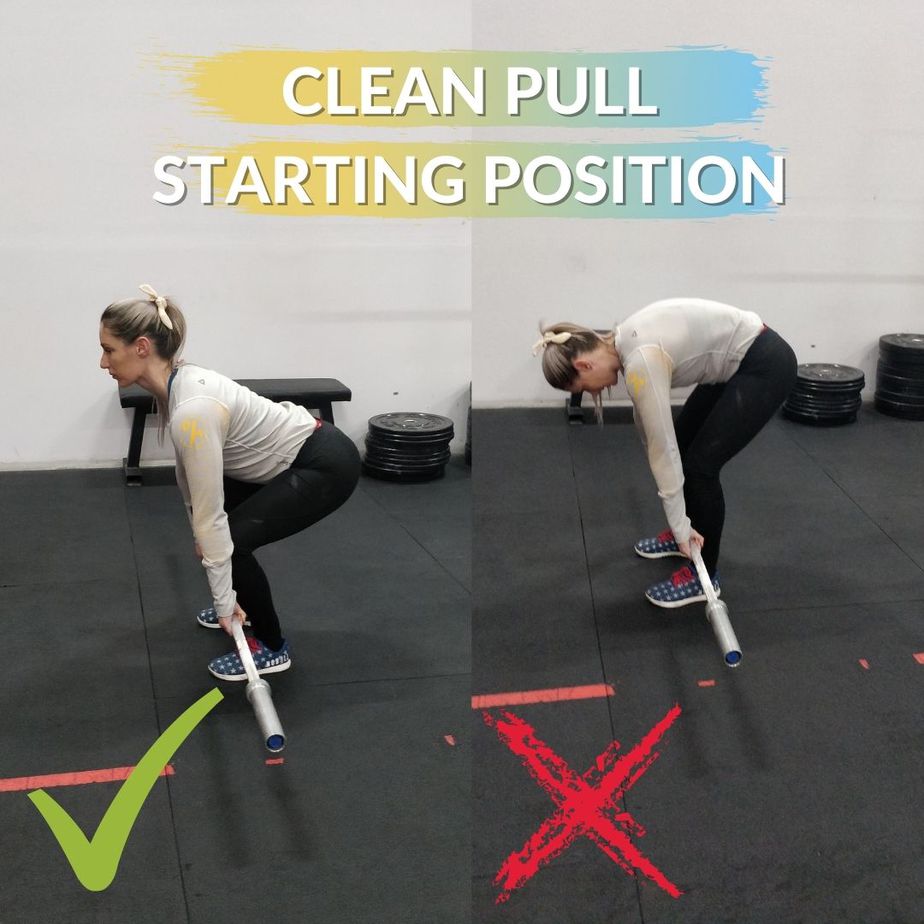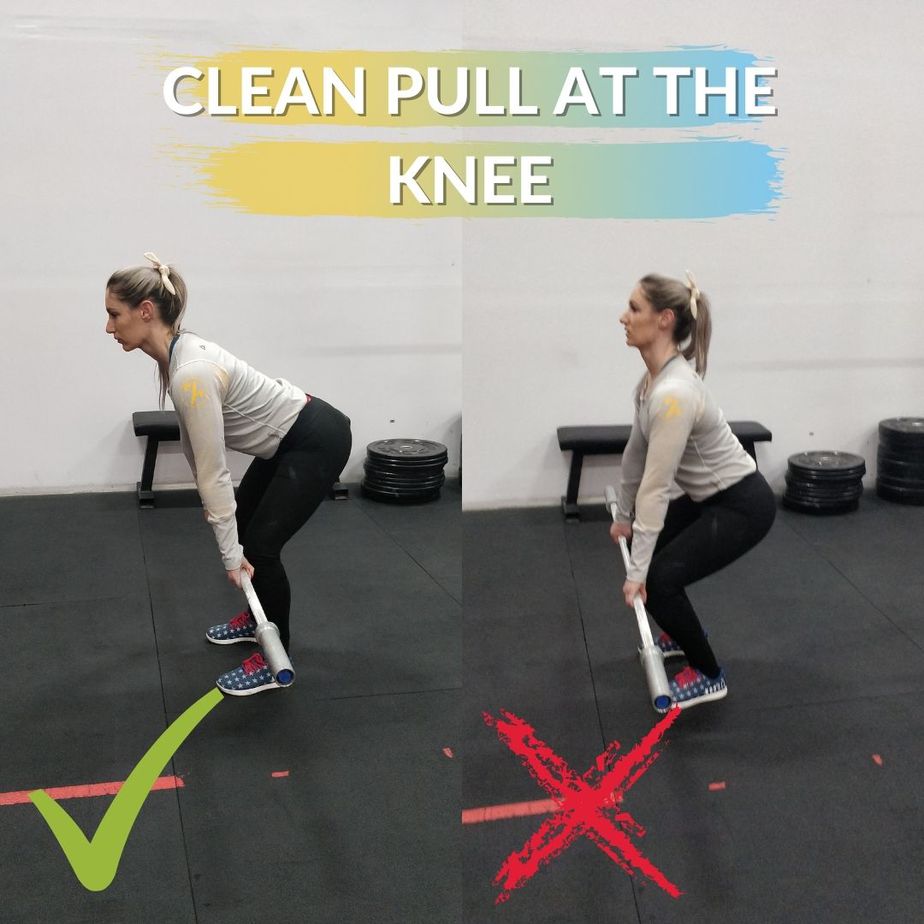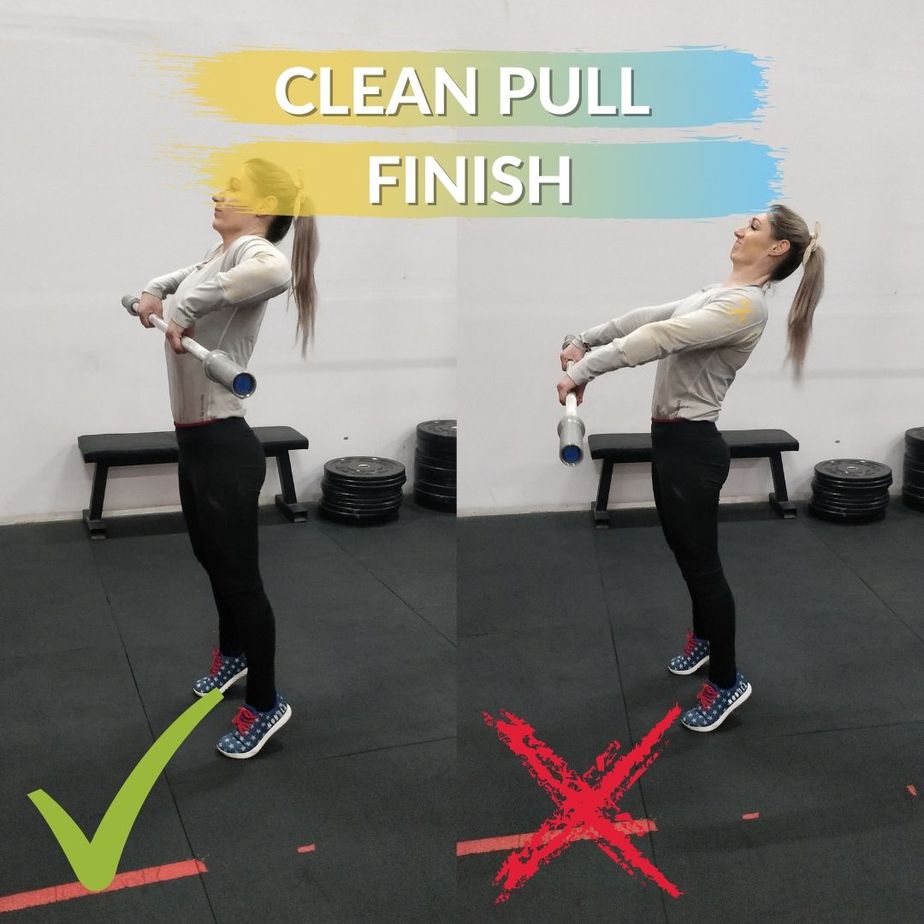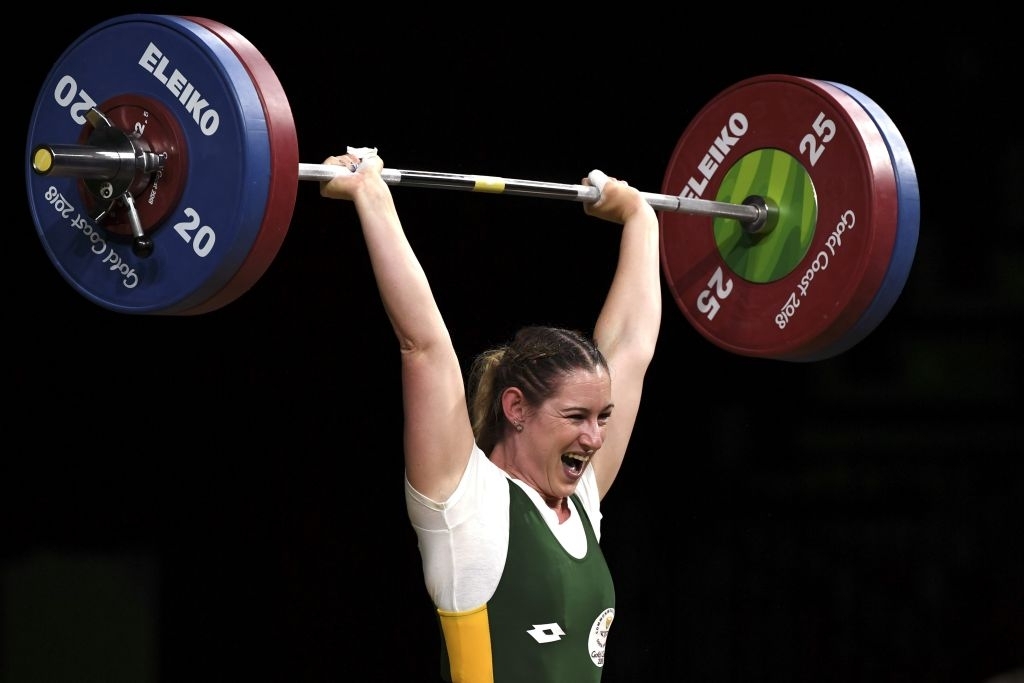The clean pull is one of the best exercises you can do for both strength building and teaching the athlete correct movement patterns in the clean. There’s a variety of clean pull variations you can do to get stronger in this movement and ultimately improve your clean.
Many Weightlifters make the mistake of performing the clean pull like a deadlift. So how do you properly perform the clean pull so it maximizes the transfer to your clean and what is the best way to program it?
Table of Contents
How To Perform The Clean Pull
The Starting Position

The starting position is very important to be able to execute a successful and safe clean. You have to make sure that your pull position from the floor is exactly the same as what you would do when performing the clean.
Start with the bar being over the middle of the foot, feet shoulder width apart or slightly wider (some athlete’s stance will vary, depending on your limb length). Usually, the bigger and longer the Weightlifter, the wider their stance will be.
Your hand position will be just wider than shoulder width. Again, this could be different for athletes battling with mobility or even with longer or shorter limb length. Those with longer arms or are less mobile may need to have a wider hand position.
When you reach down to grip the barbell, it will start either be touching your shins or be very close to them. Keep your arms relaxed but have the lats tight and engaged with a straight back. A simple cue is to think about having tennis balls under your armpits and you can’t let them fall.
Another way of getting the feeling of tight lats is to perform straight arm pulldowns before lifting as it replicates the exact feeling you will need to create in the starting position to keep the bar close.
Some athletes like having a target to look at that is just above eye level to help them straighten up their back and get the lats engaged. When starting the pull from the floor, make sure you drive your full foot into the ground or use the term “push the ground away with your feet” to get the most out of your clean pull.
The Pull

Initiate the clean pull with a straight back with the focus on a big chest while keeping your back angle the same for as long as possible. This means the hips and shoulders should rise at the same time.
Continue driving your feet into the ground, pulling the knees slightly back and out of the way until the barbell passes the knees. Once the bar has passed the knees, continue to keep the arms relaxed and lats engaged to keep the barbell as close as possible to the body.
Focus on an aggressive second pull (the pull from the knee to the hip) and bring the hips forward whilst driving to full extension or triple extension (ankle, knees and hips).
Once the barbell has brushed the high part of the thighs or even hips for some athletes, aggressively shrug the barbell up while keeping the arms relaxed and lats engaged to keep the barbell close to the body.

Common Clean Pull Mistakes
These are common clean pull mistakes that will be in sequential order from the starting position through to the full extension.
Starting With The Shoulders Behind The Bar Or Pressure On The Heels
Having the shoulders behind the barbell in the starting position, which often results in pressure being on the heels, will negatively impact how much force you can generate from the floor in your pull.
This causes the athlete to not fully extend at the top of their pull and not generate maximum power from the exercise.
Jolting The Barbell From The Ground
When the athlete aggressively jolts the barbell from the ground this will cause them to lose tension in their back resulting in tension in their arms making the movement slow and sluggish. In order to alleviate this issue, you must keep tension on the barbell before initiate the pull by taking out the slack of the bar.
If you take your barbell and put on any plates then gently pull the barbell vertically without lifting the plates, you’ll see and feel there is a very small movement. That is called the slack.
If you don’t take the slack out of the bar before initiate the pull, that small movement will cause you to move out of position affecting the rhythm of your pull.
Once the slack has been removed through creating full body tension, lift the barbell in one fluent movement and accelerate the movement as the barbell starts passing the knees instead yanking it off the floor.
Going Too Heavy Too Soon
You want to be doing the clean pull the exact way you would do the pull when you clean. Therefore, going too heavy too soon usually results in poor positioning of the back when performing the pull and therefore, not mimicking the way they would clean. Focus on getting the technique right before adding weight.
Starting Too Far Forward On The Toes
This could lead the athlete to drive forward onto the toes instead of straight up causing the athlete to not reach a full extension and jumping forward into the lift if they had to perform a clean.
Make sure to drive/push from the full foot until you pass the knees with barbell before extending onto the balls of the feet when reaching a full extension.
Pulling The Barbell Around The Knees
Pulling the barbell around the knees instead of pulling the knees back during the pull will lead to less leg drive and a change of back angle where staying over the bar is no longer possible. By pulling the barbell around the knees, it will also mess with your bar path in the clean.
Bouncing The Barbell Off The Thighs
By hitting and bouncing the barbell off the thighs during the second pull will cause the bar to move away from your body and mess with your bath path.
You want to brush the barbell up the thighs and keep the bar as close as possible to the body throughout the whole pulling movement.
Another reason for not bouncing the barbell off the thighs is to get you to extend up as high as possible with your triple extension (hips, knees and ankles).
If you bounce the bar off your thighs in during the second pull, this might lead to completing the pull and the barbell throwing off your balance and swinging the bar in the pulling movement.
Why Use The Clean Pull?
Build Specific Strength For The Clean
The clean pull is a great exercise to develop strength for the clean. Because the clean pull replicates the same mechanics as the clean but with heavier loads, this exercise will maximize the transfer of strength to the lift.
Teaching The Correct Bar Path
The clean pull teaches the Weightlifter the correct bar path during the pull. Further, it reinforces the full extension at the top of the pull before pulling themselves under the bar for the clean.
Teach Beginner Weightlifters The Positions Of The Clean
As a beginner Weightlifter, you can teach them each phase of the pull from the top down (hip, hang, below knee & floor). They can also get the feel of where the barbell will make contact at the top of the thighs or even the hips for some athletes depending on their grip width and arm length.
Which Muscles Does The Clean Pull Work?
The clean pull is a great exercise to build strength and muscle all over the body. Especially, the back, traps, glutes, quads, hamstrings, and calves.
When To Use The Clean Pull
The clean pull is performed as a strength movement for intermediate and advance athletes at the end of the session after they have completed their technical and explosive exercises.
The clean pull can be also be used at the beginning of a session when used as a complex (e.g. clean pull + clean). Further, beginner Weightlifters may use the clean pull at the beginning of their session to reinforce the correct bar path before performing the clean.
How Many Sets and Reps Of The Clean Pull?
Generally, you will perform 4-6 sets of 3-5 reps at approximately 80-110% of your clean 1RM. The lower percentages are for emphasizing speed and technique. While heavier percentages are pure strength builders to strengthen the specific positions of the clean.
Clean Pull Variations
From Block
Doing a clean-pull from the block is a great way to train the second-pull from a dead stop position where the athlete doesn’t have time to build momentum.
If the athlete needs to work on the technical aspects of the second pull, or are learning to stay over the bar longer, or need to emphasize an aggressive second pull, then this is a great exercise variation to do.
From Hang
Another great exercise to build strength and create some time under tension if the athletes need to build back strength is the clean pull from the hang. Try not to rush this movement to emphasize staying over the bar and sometimes pausing for a second or two in the hang position.
The clean pull from the hang can be performed from hip, hang, or even below knee depending on what your goal is for the exercise.
With Pauses
Training the pull with a pause really emphasizes strength in specific positions by creating a time under tension effect. Focus on keeping the position as close as possible to how it will look when performing the clean.
Pauses can be held below the knee, above the knee, high hang or even the hip and can be performed during the pull or even on the descent during the eccentric.
With Tempo
Tempo pulls are a great way to teach the athlete correct positioning or even to develop immense strength. A tempo can be prescribed on the upward or downward phases or even both depending on the goal of the exercise. Generally, you will prescribe a tempo of about 3-5 seconds.
Partials
Partial clean pulls are a great way to break the movement down to emphasize certain parts of the pull or as a strength building exercise to get the athlete strong in certain positions.
Generally, the athlete will perform the partial clean pull from the floor to the knee or from the floor to above the knee to teach the athlete to push with their legs and keep their back over the bar for as long as possible.
From Platform/Riser
A clean pull from the riser, also called a deficit clean pull, is a great way to make the pull longer. This is a great strength building exercise and teaches the athlete that doesn’t complete their pull to pull over a longer distance creating a feeling of “pulling for longer.”
This feeling is then carried over to their classical clean so they don’t cut their pull short. Normally athletes will stand on a small wooden platform or even some plates to create a deficit for the pull.
The athlete needs to focus on pushing with the legs for longer, staying over the bar and making sure they fully complete the pull.

 (@powerfulpretorius)
(@powerfulpretorius)